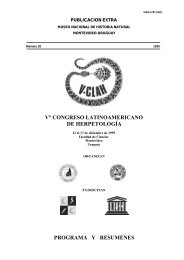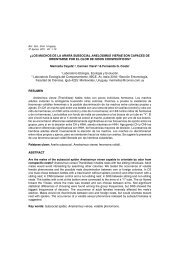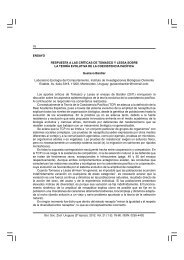Primer Congreso Uruguayo de Zoología - Sociedad Zoológica del ...
Primer Congreso Uruguayo de Zoología - Sociedad Zoológica del ...
Primer Congreso Uruguayo de Zoología - Sociedad Zoológica del ...
You also want an ePaper? Increase the reach of your titles
YUMPU automatically turns print PDFs into web optimized ePapers that Google loves.
PHYLOGENETIC ANALYSIS AND TAXONOMIC REVIEW OF THE GENUSMicroschemobrycon EIGENMANN, 1915 (CHARACIFORMES: CHARACIDAE)Cavallaro, M.R. & R.M.C. CastroUniversida<strong>de</strong> do São Paulo, Brazil, mrcavallaro@gmail.comThe genus [Microschemobrycon] Eigenmann, 1915 is hypothesized to be monophyletic based on analysis of 193characters and 25 taxa. [Microschemobrycon] is phylogenetically diagnosed based on synapomorphies <strong>de</strong>scribedfrom osteological characters and external morphology analysis. This genus is currently inclu<strong>de</strong>d in Aphyoditeinae andrelated to Aphyocharacinae and Cheirodontinae (Miran<strong>de</strong>, 2009). Here it is also related Aphyocharacinae andCheirodontinae. A total of nine species are recognized and consi<strong>de</strong>red valid, two of which are <strong>de</strong>scribed. All speciesinclu<strong>de</strong>d in this genus are reviewed and re<strong>de</strong>scribed based on examination of type material and additionalcomparative material. The knowledge of distribution area and feeding habits of the Microschemobrycon species areincreased significantly.A NEW ECTOPARASITIC THRIPS (INSECTA: THYSANOPTERA) FROM THE BRAZILIANAMAZONIAN RAIN FORESTCavalleri, A. 1 ; F. S. Melo 1 ; L. A. Kaminski 2 & M. S. Mendonça 11 Universida<strong>de</strong> Fe<strong>de</strong>ral do Rio Gran<strong>de</strong> do Sul, Brazil. 2 UNICAMP. Brasil. fabiosmelo@hotmail.comThe majority of the 5,800 thrips species are phytophagous, nearly 40% are fungivorous and few are facultative orobligate predators on other arthropods. However, one particular group, the Aulacothrips genus, was recentlyrecor<strong>de</strong>d as ectoparasite of honey<strong>de</strong>w producing hemipterans (Auchenorryncha). Two species are inclu<strong>de</strong>d in thisgenus, Aulacothrips dictyotus Hood and Aulacothrips minor Cavalleri, Kaminski & Mendonça. The first attacks onlyAetalion reticulatum bugs while the second infests several treehopper species. Both species ectoparasitize nymphsand adults of Hemiptera, laying their eggs in the plant tissue, near bug aggregations. They were previously recor<strong>de</strong>din several Cerrado areas in Brazil, sometimes living in sympatry, but infesting distinct hemipteran hosts. However,recent studies showed a third Aulacothrips species infesting Membracidae in the Brazilian Amazon Rain Forest. Thisnew taxon was collected in July 2010, infesting Ramedia sp. ant-ten<strong>de</strong>d aggregation on Solanum sp. shrubs, inJurupari Island (01°36’S, 52°45W), Pará State. Larvae, 17 females and 12 males were found living together, most ofthem attached to the bodies of the hemipterans as A. dictyotus and A. minor do. Several morphological differenceswere observed between this thrips and the other Aulacothrips species: (i) the color of the body is distinctively paler;(ii) the sensoria on antennal segments III & IV are remarkably less convoluted; (iii) the posterior margin of the maletergite IX is straight and bears several long and stout setae. According to morphological structure, this new speciesseems to be closely related to A. minor. The sample area where this thrips was collected is about 1,500 km far fromthe current A. dicyotus and A. minor geographical distribution. This new finding will help to reconstruct theevolutionary scenario behind this remarkable system involving Aulacothrips, and hints at an un<strong>de</strong>scribed diversity forthis group.166 <strong>Primer</strong> <strong>Congreso</strong> <strong>Uruguayo</strong> <strong>de</strong> <strong>Zoología</strong>







